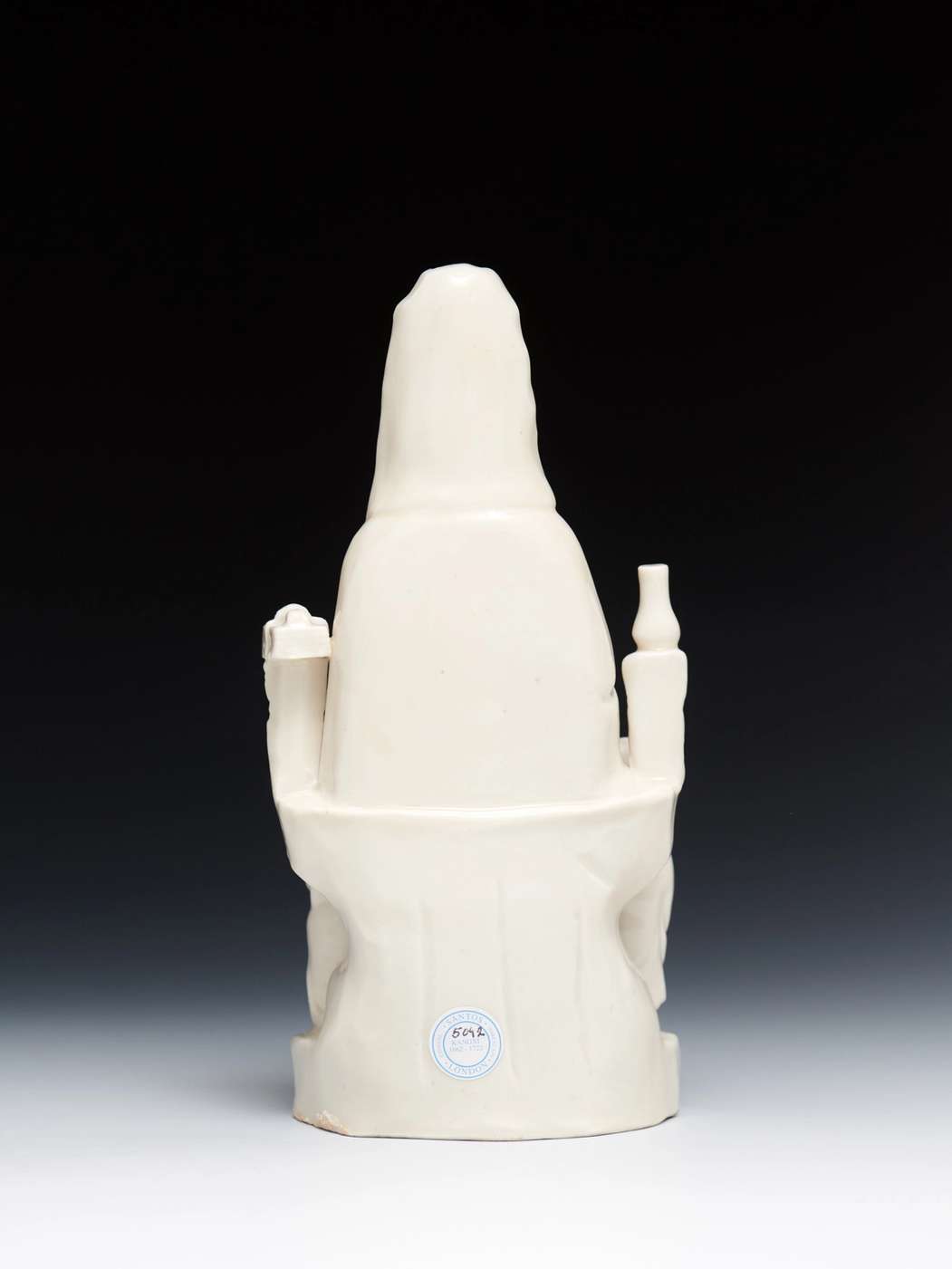Click the above image to zoom
Dehua porcelain (blanc-de-chine) figure of a Guanyin, Kangxi.
Sold
Stock Number: 5042
Fine Chinese export Dehua porcelain (blanc-de-chine) figure of a Guanyin with a serene expression holding a child, seated on a lotus flower above a coiled fierce looking four claw dragon, two attendants at her feet and above two pedestals with a bottle and a book, c. 1720, Kangxi reign, Qing dynasty, h. 22 cm, 8 ¾ in; w. 10 cm, 4 in. 7-18362
Literature: Blanc de Chine, by P.J. Donnelly, plate 75 for a similar but larger figure.
Provenance: Collected and sold by the descendants of D. Pedro de Sousa Holstein, 1st Duke of Faial and Palmela, Portugal.
◆ D. Pedro de Sousa Holstein, 1st Duke of Faial and Palmela (1781–1850) was one of the most important Portuguese diplomats and statesmen in the first half of the 19th century. He also served as the country's first official Prime Minister (Presidente do Conselho de Ministros de Portugal, "President of the Council of Ministers of Portugal"), the office in essence having already existed.
He was born in Turin, a scion of the Portuguese de Sousa family, Lords of Calhariz.
The 'Holstein' element of his family name came from his paternal grandmother Princess Maria Anna Leopoldine of Schleswig-Holstein-Sonderburg-Beck, daughter of Frederick William I, Duque of Schleswig-Holstein-Sonderburg-Beck.
His uncle Frederico Guilherme de Sousa had been governor of Portuguese India.
He earned notoriety at an early age by telling Napoleon to his face at the conference in Bayonne in 1808 that the Portuguese would not ‘consent to become Spaniards’ as the French Emperor wanted.
He was Portuguese plenipotentiary to the Congress of Vienna in 1814, where he attempted to press Portugal's claims to Olivenza, and to the Congress of Paris in 1815.
After this he was briefly ambassador to London, but then was appointed secretary of state for foreign affairs in Brazil. After the Portuguese Revolution of 1820 he was commissioned by the revolutionary junta to inform the king, João VI, of what had taken place and to request his return to Portugal from Brazil.
In 1823 he was made a Marquis and became foreign minister as well as head of the committee, which D. João appointed to devise a new constitutional charter. The resulting document, to which the King was unable to agree, was so liberal that it drew down on Palmela the hatred of the reactionary forces in the country, especially the Queen and the Infant Dom Miguel, who in 1824 had him arrested.
After he obtained his liberty, he was nominated a minister of state and returned to London as ambassador.
精美的中國外銷德化白瓷送子觀音像,像中觀音面容慈祥,懷抱童子,坐於一朵蓮花之上,花下一條蜿蜒兇猛的四爪龍,觀音腳邊兩個仕童站在座子上,上面分別放有一個瓶子和一本書,約1720年,清康熙,高22釐米,8¾英吋;高10釐米,4英吋。
參考文獻:《中國白瓷》,作者P.J. Donnelly, 見彩圖75一件相似但是尺寸較大的塑像。
◆ D. Pedro de Sousa Holstein是第一任法亞爾和保梅拉公爵(1781-1850),也是19世紀上半葉最重要的葡萄牙外交官和發言人之一。儘管當時已有相似的職位存在,他仍稱得上是首任國家首相(Presidente do Concelho de Ministros de Portugal, “葡萄牙部長理事會主席” )。
他出生在都靈,其家族是Calhariz勛爵,Portuguese de Sousa大家族的一個分支。他的姓中“Holstein”一詞來自他的祖母,Schleswig-Holstein-Sonderburg-Beck的Maria Anna公主,公主的父親是Schleswig-Holstein-Sonderburg-Beck勛爵,Frederick William 一世。
他的叔叔Frederico Guilherme de Sousa曾是葡屬印度的總督。
D. Pedro de Sousa Holstein曾在1808年貝永的一場會議中直面拿破崙,表示葡萄牙人絕不會遵循法國國王的意願而成為西班牙人。正因為這次的衝突,讓年紀輕輕的他獲得了爵位。
1814年在維也納會議中,作為葡萄牙全權發言人的他向奧利文薩表達了葡萄牙的訴求,隨後又在1815年在巴黎會議中再次提出要求。
在那之後,他曾短暫擔任駐倫敦大使,之後又被任命為巴西外交部長。1820年葡萄牙革命后,革命軍政府召集他,讓他去把革命成果通告訴國王João六世並要求國王從巴西返回葡萄牙。
1823年,國王João六世又被要求出台新的憲法章程。而D. Pedro則被任命為侯爵,并擔任外交部長和議會主席。新的憲法章程因太開放和自由,不僅得不到國王的認同,還點燃了以王后和Infant Dom Miguel為首的國家反對力量的怒火。在1824年,D. Pedro被補。
在D. Pedro重獲自由后,他又被任命為國務大臣和駐倫敦大使。


